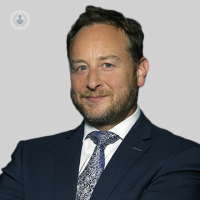Flat feet in children: a cause for concern?
Written by:Flat feet occur when the arches of the feet collapse, causing the entire sole to touch the ground, and can occur due to genetic factors. If a child has flat feet, this could be a cause of concern for some parents. Leading consultant orthopaedic surgeon Mr Andrew Goldberg addresses any concerns you may have about your child’s flat feet.

What is meant by flat feet?
A typical foot naturally possesses arches, ensuring that the instep remains elevated from the ground. This is attributed to the structural configuration of the foot bones, along with the support of muscles, ligaments, and tendons, collectively forming the crucial arch. This arch is essential, acting as the spring in your step. However, when the arch weakens and the instep makes contact with the ground, this condition is commonly referred to as flat feet.
How common are flat feet in children?
Until around the age of four, it's common for nearly all children to have flat feet, which is perfectly normal. Between the ages of five and ten, as children grow, their arches typically begin to form. By the age of ten, approximately twenty per cent of children may still have flat feet.
You can determine if your child has flexible flat feet by asking them to stand on their tiptoes, causing their foot arches to reappear. This suggests that the cause may be related to joint flexibility or weak muscles.
However, if the arch fails to reappear, it's classified as fixed flat feet. In such cases, it's advisable to seek evaluation from a specialist to uncover the underlying cause, as many conditions can be effectively treated if identified early.
What can happen if my child's flat feet are left untreated for long enough?
The majority of children with flat feet experience no symptoms and proceed through life without any issues. Even the fastest man on earth, Usain Bolt, has flat feet without experiencing any problems. However, in a minority of cases, flat feet may be linked to conditions such as hypermobility, knee pain, or back pain.
If a child has these issues, it's best to seek help from a specialist, as there are various treatments and interventions available to alleviate these symptoms.
How are flat feet corrected? Is surgery always required?
For children, engaging in physical activities, particularly those that target balance muscles like walking on tiptoes or picking up objects with their feet, is crucial. Balance exercises with a physiotherapist can also be beneficial. Insoles are sometimes recommended as they can provide support by bringing the floor up to the foot, preventing the foot from collapsing downward.
However, in cases where a child's feet remain highly flexible and insoles prove ineffective, ongoing issues may persist. In such instances, a small surgical procedure called an arthroereisis may be considered. This procedure involves implanting a small device into the back of the ankle to help control the collapsed arch. It is important to emphasise that both insoles and surgery are supplementary measures—they assist but do not replace the need for daily exercises and physiotherapy, which are the most important measures to avoid such issues.
If you are concerned about your child’s flat feet and would like to book a consultation with Mr Goldberg, simply visit his Top Doctors profile today.


